The ‘Great Lake State’ of Michigan didn’t get that nickname by chance, with 4 great lakes (Michigan, Erie, Superior, and Huron) sharing its borders. With mountain forests in the Upper Peninsula and hills and shorelines in the Lower, Michigan is a great place for birds and birding. Today we are going to talk about the popular backyard birds of Michigan and give you the inside scoop on what they like to eat, where they like to hide, where you can seek them out, and more!
Without further ado, let’s get started!
3 Categories – 450 Birds
With all that varied geography Michigan is indeed a great place for birds. So much so, that the states hosts in excess of 450 different species either full time or at various migration windows throughout the year. While we’d love to list the all here we haven’t got that kind of space today so instead, we’ll give you a sampling to get you started and divide it up like this:
- Year-round Resident birds
- Birds of Spring, Summer, and Early Fall
- Fall and Winter Birds
Identifying information will be provided for each bird, including tips for luring them for a closer visit to your backyard feeders. Following this we’ll give you extended feeder advice for attracting the most birds that you can and we’ll even tell you where to find them around the state if you feel like a little birdwatching time. Let’s start with the full-timers, Michigan’s year-round residents.
Michigan’s Year-round Resident birds
The birds in this category have made Michigan their permanent home. This means that there are out and about, foraging around the state at any given time of year. Keep an eye out and see if you can spot one of the following year-round resident birds this year:
- American Goldfinch
- Northern Cardinal
- European Starling
- Tufted Titmouse
- Red-bellied Woodpecker
American Goldfinch – Spinus tristis

Coloration and Markings: Male American Goldfinches have bright yellow backs with long, black wings which have 2 white wingbars as well as a number of vertical markings towards the center, lower back. They have short, notched tails which are black with white markings as well and there is some white on the undersides, coming from the rump. The underbelly and breast of this bird take the color back to bright yellow and this color carries up into the face, interrupted only by a small, black cap across the forehead and a conical, medium-length orange bill. Female Goldfinches tend to be olive instead of black and will have a less vibrant yellow than the males and in the winter, both birds adopt a brown plumage with dark wings and barely visible wingbars.
Size: These birds measure in at 4.3 – 5.1 inches in length and have wingspans of 7.5 to 8.7 inches wide.
Habitat: Goldfinches like to forage in fields, especially those which are prone to flooding, but they are also fond of orchards, gardens, and backyards with well-stocked feeders.
Diet: Nyjer thistle and Black Oil sunflower seeds are a simple and effective combination which you may use to lure the American Goldfinch to your feeders.
Northern Cardinal – Cardinalis cardinalis
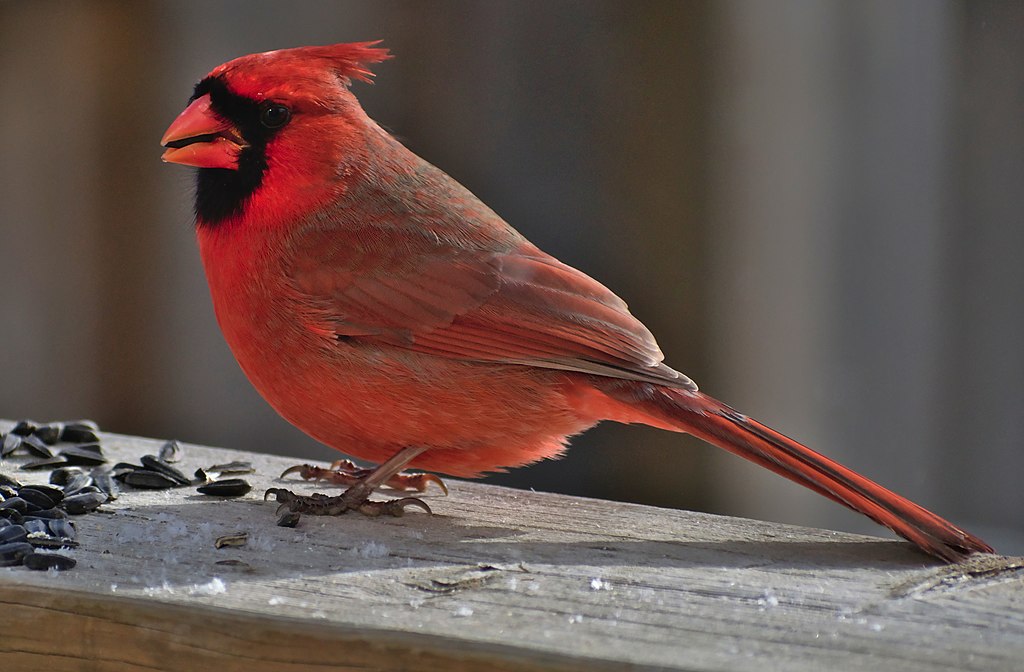
Coloration and Markings: Male Cardinals have amazing plumage, being almost completely red all over their bodies. They have medium-length red wings and long, red tails, both of which will sometimes have bits of brown if the bird is molting. Facially, you’ll notice first the majestic, red crest of the Cardinal and its distinctive black mask, which covers the eyes and pulls sharply down to the bird’s chin. These birds have short, stout, conical orange-red bills and the females, while very different in color, are no less striking. Female Cardinals exhibit a brown plumage, with reddish tinges at the crest, wings, and tail.
Size: These birds measure in at 8.3 – 98.1 inches in length and have wingspans of 9.8 to 12.2 inches in width.
Habitat: Cardinals like the forest’s edge, especially if there is some dense vegetation in the form of shrubs, brambles, of thorns where they can occasionally get a little cover for relatively-safe foraging. These bold birds are also found quite often in parks and backyards, however, so be sure to keep an eye out for them. That stunning plumage is very hard to miss!
Diet: White milo, crushed peanuts, and cracked corn are 3 favorites of the Northern Cardinal that you can use to tempt a Cardinal to your feeder so that you can get a closer look!
European Starling – Sturnus vulgaris
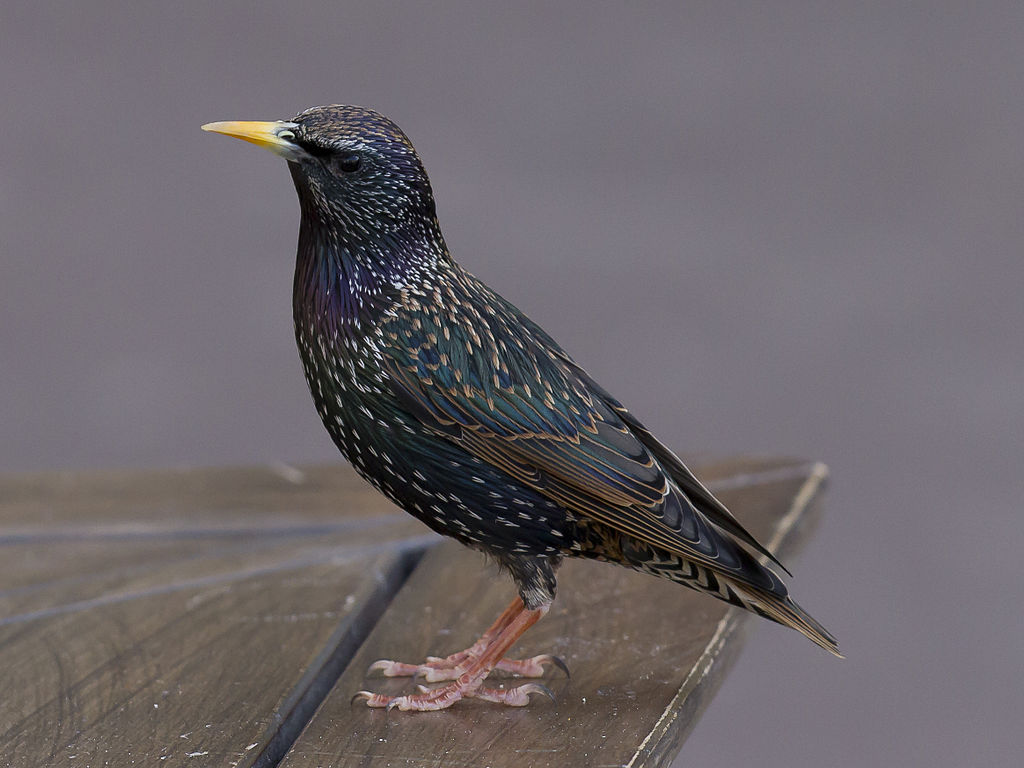
Coloration and Markings: When it is warm European Starlings appear black from a distance, but up close you can see that their overall plumage is a lovely mix of purples and greens. They have medium-length wings and short, stubby tails, and facially they have long, thick, and pointed yellow bills. In the winter, they make a dramatic change into brown plumage with beautiful white spots on them, so try to spot them in the warm and the cold months… you’ll appreciate the contrast!
Size: These birds measure 7.9 – 9.1 inches from tip to tail and have a wingspan of 12.2 to 15.8 wide.
Habitat: Starlings are found most often in the same places that we are. These birds know that the foraging is good when humans are nearby, so you most commonly see them in farms or in the city, on fences and phone lines, and sometimes even in local parking lots. They will definitely visit your feeder once they have become aware of it!
Diet: Starlings love fruits and most kinds of grains as well, but their favorite is suet. They will eat all of it that you’ve got, in many cases, and if this is a problem then you might want to leave out some wheat, oats, and raisins and invest in a Starling-proof suet feeders so that you can save some for the other birds.
Tufted Titmouse – Baeolophus bicolor
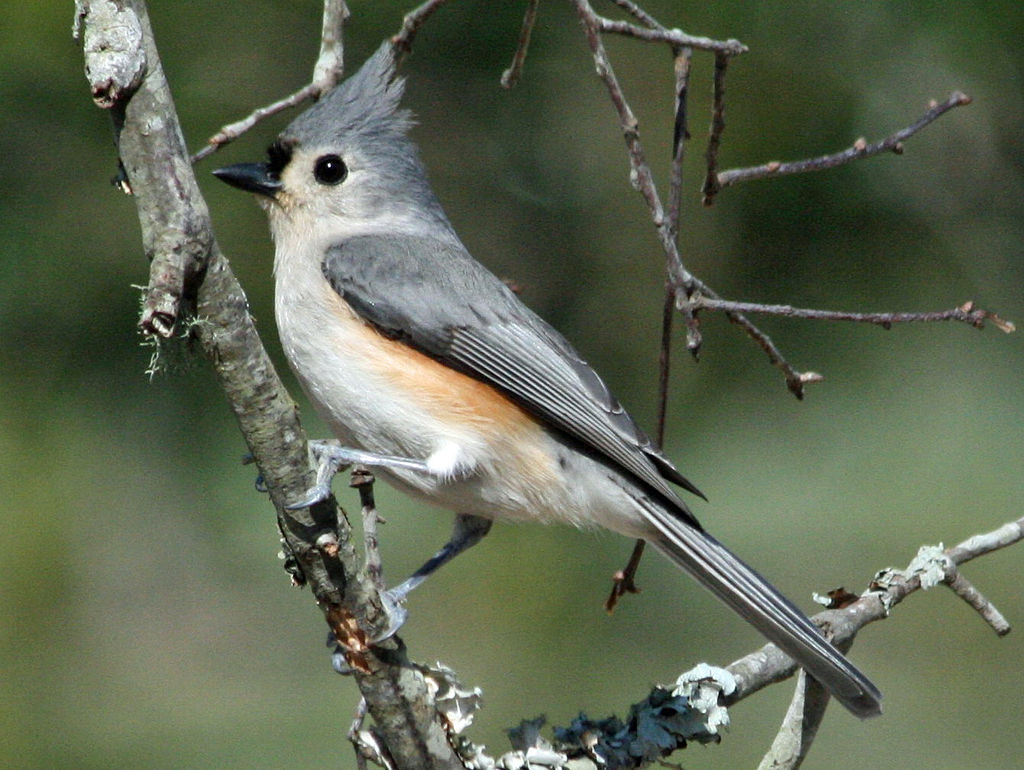
Coloration and Markings: Tufted Titmice have blue-gray backs with short, blue-gray wings and long, blue-gray tails which are white on the undersides. The underbelly and breast of this bird are white, with a light wash of peach present just underneath the wings. Facially, these birds are white on their chins, cheeks, and around the eyes, with bluish-gray at the back and the top of the head. These birds have tiny, lovely crests and you will also notice a square-shaped black mark just above the small, stout, and triangular black bill.
Size: These birds measure 5.5 – 6.4 inches from head to tail and have wingspans of 7.9 to 10.2 inches wide.
Habitat: These birds prefer evergreen and deciduous woods, especially at lower elevations. They do tend to range out, however, and you might just spot them in an orchard, park, or backyard nearby.
Diet: Suet, peanuts, and Black Oil sunflower seeds are all favorites of the Tufted Titmouse and their inclusion in your feeder can quickly earn you a new feathered friend.
Red-bellied Woodpecker – Melanerpes carolinus

Coloration and Markings: Red-bellied woodpeckers have black and white striped backs with long, striped wings and short, stiff tails that are striped as well. The underbelly and breast of this bird are white, with the exception of a reddish mark present on the underbelly and splashes of red color that look as if the bird has been messily drinking juice. Facially, these Woodpeckers have white faces, with a long, red cap that goes down to the nape of the neck and with more splashes of red at the cheeks. These birds have long, thick, and straight black bills.
Size: These birds measure in at 9.4 inches, on average, from tip to tail and they have wingspans which are 13 to 16.5 inches in width.
Habitat: These birds love the deep woods, where they are typically found within stands of hardwood trees, but they do range out when they are foraging and are regular visitors to backyards with full-feeders.
Diet: While they will eat sunflower seeds if you’ve got them, one of the best ways to lure a Red-bellied woodpecker is to simply nail and orange to a tree near your feeder. These birds absolutely love them!
Michigan’s Birds of Spring, Summer, and Early Fall
The first sign of spring in Michigan is generally the arrival of the American Robin. Michigan winters take a long time to admit defeat but when the Robins show up you know that the long wait is over. During this time and the months to follow Michigan gets quite busy from a birding prospective. Here are birds that you can look for all the way up into early fall:
- Indigo Bunting
- Gray Catbird
- Red-eyed Vireo
- Eastern Wood-Pewee
- American Robin
Indigo Bunting – Passerina cyanea

Coloration and Markings: Male Indigo Buntings are a sight to see. Almost completely indigo blue, with the occasional grays seen at the edges of their short, blue wings and short, blue tails, you will see a coloration exception in the face in the form of some black just in front of the eyes. These birds have stout, medium-length silver bills and females, while lovely, have quite different plumage. They tend to be mostly brown or olive colored, with some olive or brown streaking at the breast and light tinges of blue in the wings, breast, and lower parts of the face. Juvenile males will be a mix of browns and blues, gaining more blue in their plumage as they slowly mature.
Size: These birds measure in at 4.7 – 5.1 inches in length and have wingspans of 7.5 to 8.7 inches wide.
Habitat: These birds like areas with high grass or weeds which are also close to woods. Birds of brambles, briars, thickets, and thorns, they do visit the occasional backyard so be sure to leave a little something out for them.
Diet: Nyjer thistle, Black Oil sunflower seeds, and live mealworms are 3 favorites of the Indigo Bunting but you can also leave out just about any sweet berries that you have on hand to lure them as well.
Gray Catbird – Dumetella carolinensis

Coloration and Markings: Gray Catbirds are beautiful and quite easy to identify. Most of their bodies are going to be a stone-gray color, with some small exceptions which we will detail shortly. They have broad, medium-length wings that give a ‘humped’ look to their backs and they also have long, rounded tails that are dark gray to the point of almost being black. The undersides of the feathers will have white-edged black and the rump of this bird is a foxy reddish-brown. Facially, these birds have a black cap and a straight, black bill with curvature present on the upper bill.
Size: These birds measure in at 8.3 – 9.4 inches in length and have wingspans of 8.7 – 11.8 inches.
Habitat: Catbirds like small trees with a lot of brush cover nearby. They are quite fond of thickets near water and are also found quite commonly in weedy fields or other areas with high grasses.
Diet: These birds have a huge sweet-tooth, so you can lure them quite effectively with orange halves topped with grape jelly!
Red-eyed Vireo – Vireo olivaceus
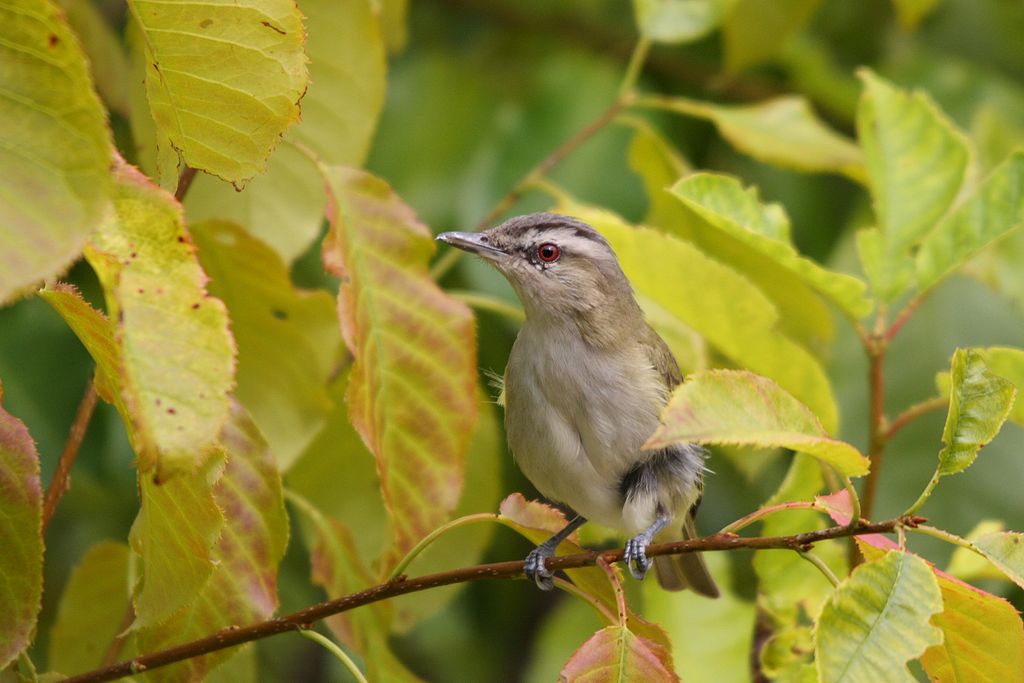
Coloration and Markings: Red-eyed Vireos have backs which are olive and green (with yellows sometimes) and they have medium length wings and short tails which are grayish with yellows or greens mixed in as well. The underbelly and breast of this bird are white, with some yellow or green just below the wings and facially, Vireos have mostly olive colored faces with some white around the eyes, a thin olive eyestripe, and an angular ‘eyebrow’ just below a puffy, silver crown. These birds have medium-length, gray or grayish-black bills with a very minute hook at the tip. We should note that while adults have red eyes, juveniles will only display brown ones.
Size: These birds measure in at 4.7 – 5.1 inches from tip to tail and have wingspans of 9.1 to 9.8 inches in width.
Habitat: Red-eyed Vireos prefer to spend their time in deciduous woods and you should look for them nearby if you happen to see maple trees. Vireos are quite fond of them. They can be found in any type of woods, however, once it’s time to migrate, so keep an eye out and you might just spot one!
Diet: While primarily insectivorous, these birds do supplement their diets with berries from time to time. Try leaving out some blueberries or strawberries in your feeder and you might just get their attentions!
Eastern Wood-Pewee – Contopus virens
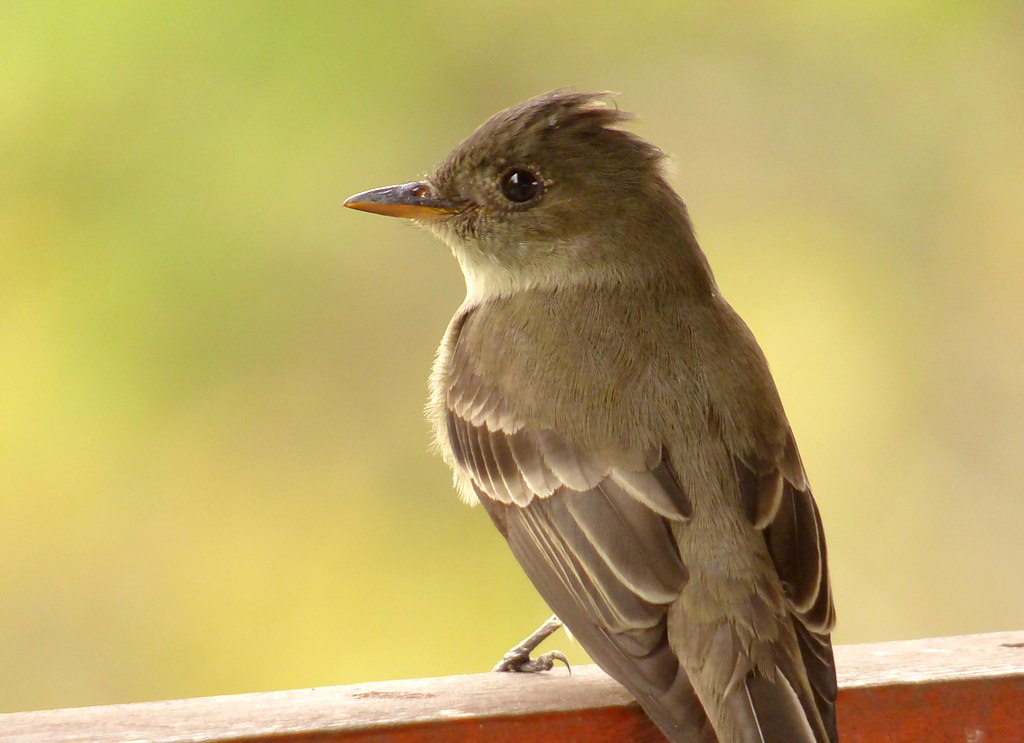
Coloration and Markings: Eastern Wood-peewees have dark gray backs, with long, dark gray wings and tails. The wings have 2 thin, white wingbars, as well as some white edging on the feathers towards the center. Peewees have an off-white rump, underbelly and breast and facially, they have a small, lovely gray crest and some white around the eyes, as well as a white chin. These birds have short, straight gray bills which are typically orange on the lower bill and have a slight hook on the tip of the upper one. Juveniles will display buff/tan colored wingbars as well.
Size: Peewees measure in at approximately 5.9 inches from tip to tail and have wingspans of 9.1 to 10.2 inches wide.
Habitat: While these birds prefer deciduous woods, they may be found in just about any wooded area and are also fond of woodlots.
Diet: These birds are primarily insectivorous, so they are unlikely to visit your feeder. That said, they have visiting sometimes for suet but we cannot guarantee that this will work with every Peewee.
American Robin – Turdus migratorius
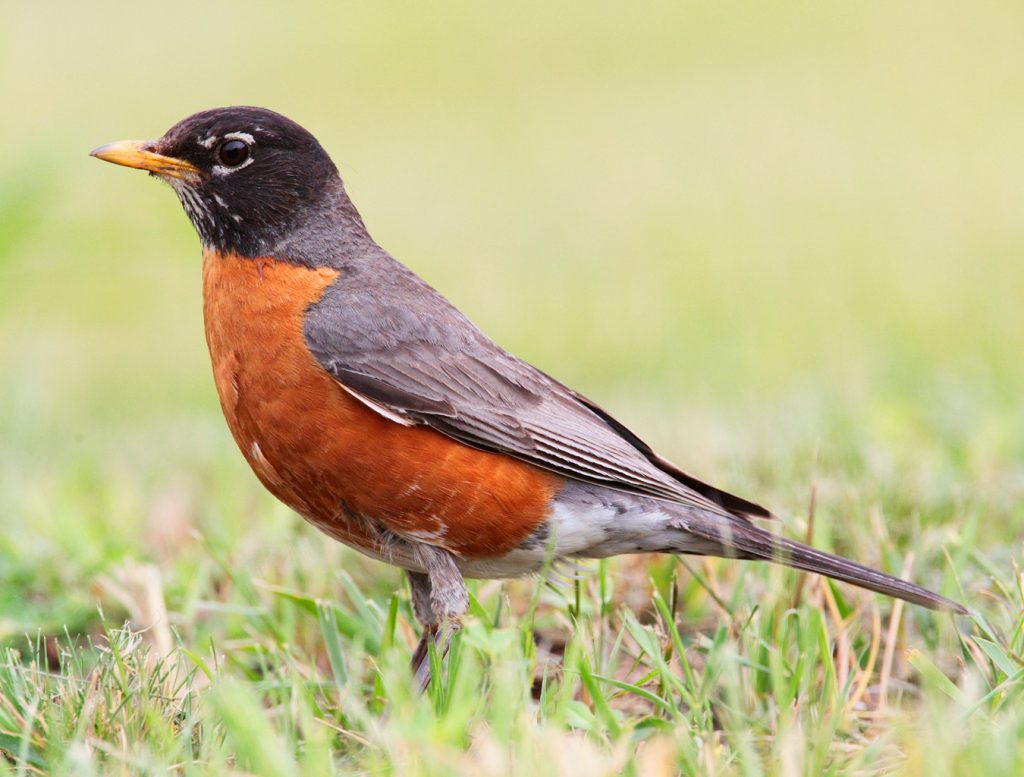
Coloration and Markings: American Robins have grayish-brown backs with medium-length wings and long tails of the same color. The tails will have some white, coming from the rump, while the breast and underbelly of the Robin are a dark tangerine orange color. Facially, these birds have black heads, with white eyerings which consist of ‘broken’ pieces encircling each eye and these birds have medium-length, slightly-curved yellow bills. Female Robins have the same coloration but with much less contrast.
Size: The birds measure in at 7.9 – 11 inches in length and have wingspans of 12.2 to 15.8 inches wide.
Habitat: Robins are bold birds and may be found in many places. They prefer deciduous woodlands but are often found in golf courses, parks, pine stands, or even foraging in the snow.
Diet: Crushed peanuts, raisins, and Black Oil sunflower seeds are 3 favorites of the American Robin that can sometimes lure them in for a closer look.
Michigan’s Fall and Winter Birds
Michigan winters are not for the faint of heart, with temperatures dropping as low as -20 degrees Fahrenheit in the northern highlands! That said, even though you and I might not want to go out in that weather, a number of our feathered friends are foraging, nonplussed, right out there in the cold. Be sure to bundle up in your warmest coat and get out to the backyard to fill what feeders you can. Here are a few of appreciative Avians that you might just see if you do:
- Dark-eyed Junco
- House Finch
- White-breasted Nuthatch
- American Pipit
- Horned Lark
Dark-eyed Junco – Junco hyemalis

Coloration and Markings: Dark-eyed Juncos have a lot of regional variance in their plumage, but a typical Junco has a dark brown or gray back, with short, gray wings and a long, gray tail, which is white on the undersides. The underbelly and breast of this bird are white, with a heavy flanking of gray at the sides which gives the appearance of an even distribution of white on the lower 1/3 of the body. Facially, these birds have dark gray or brown faces and stout, medium-length pink bills.
Size: These birds measure in at 5.5 – 6.3 inches from tip to tail and have wingspans of 7.1 to 9.8 inches wide.
Habitat: When it is warm, Juncos prefer deciduous or mixed deciduous woods but they also range out, spending time in parks, fields, and backyards with well-stocked feeders.
Diet: Sunflower seeds and cracked corn are all that you need to make a Dark-eyed Junco very happy and potentially a regular visitor to your backyard feeder.
House Finch – Haemorhous mexicanus
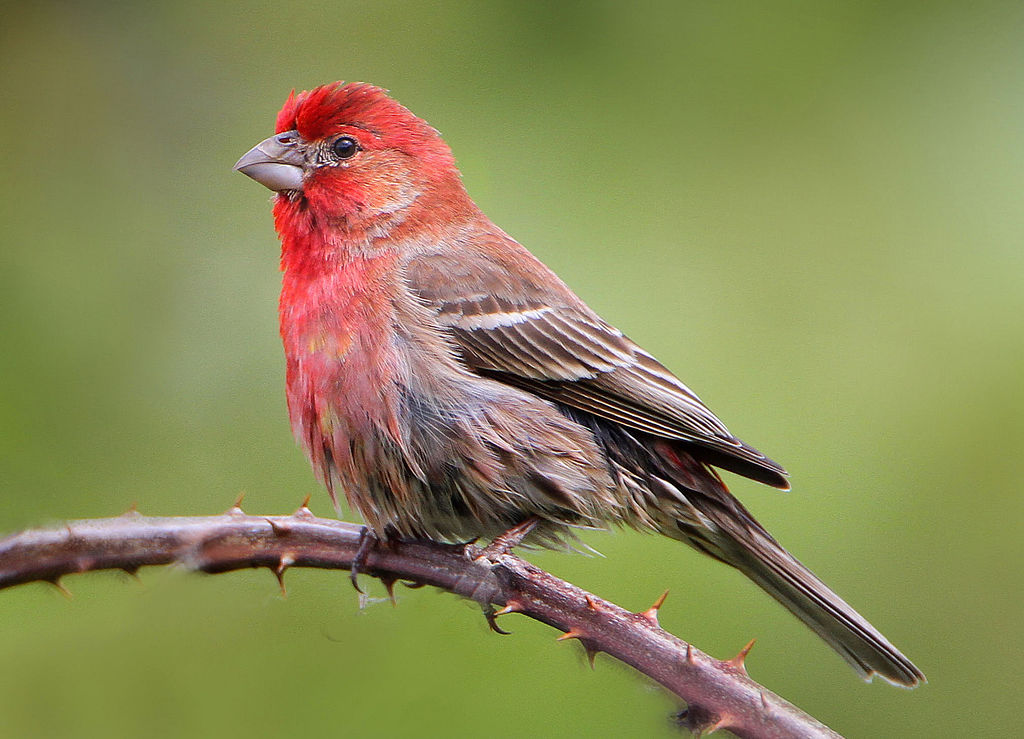
Coloration and Markings: Male House Finches have gray, brown-streaked backs, with short, gray wings and medium-length, notched gray tails. The wings exhibit 2 white wingbars each and some white, vertical edging. The underbelly and breast of this bird is white, with raspberry-red streaking on the underbelly and concentrations of raspberry color at the breast. Facially, this bird has a mostly-red face, with a silver eyeline that passes the eyes and splits, with one line curving around to highlight the cheek and the other going towards the back of the head. The top of this bird’s head is a thin layer of gray color and it has a short, stout, and lightly curved silver bill. Females will lack all red coloration, presenting as grayish-brown with heavy streaking at the breast and underbelly and lacking the facial markings of the male.
Size: These birds measure about 5.1 – 5.5 inches in length and have wingspans of 7.9 to 9.8 inches wide.
Habitat: House finches like to spend their time around the forest’s edge, but they are also frequent visitors to farks, parks, and city backyards. You can also see them in open, wooded areas and even stretches of desert, provided that there is an ample amount of scrub or brush-cover.
Diet: Add some Black Oil sunflower seeds and suet to your backyard feeder foods and you are ready to host visiting House Finches at your backyard feeder.
White-breasted Nuthatch – Sitta carolinensis

Coloration and Markings: White-breasted Nuthatchs have bluish-gray backs with long, gray wings which have minor black edging and a thin white wingbar on each. They have short, bluish gray tails which are white underneath and the rump, underbelly, and breast of this bird are white, with the exception of a rust-colored spot located in front of the rump. Facially, these birds have white faces, with black caps which go down to the nape of the neck and extend lightly on the back of the shoulders, as well as a diagonal black line going up from the back of the eyes. These birds have long, straight bills which tend to be black on top and grayish-white on the bottom.
Size: These birds measure in at 5.1 – 5.5 inches from head to tail and have wingspans of 7.9 to 10.6 inches wide.
Habitat: These birds love the forest’s edge but they are also at home in the deep woods. Look for them around trees which they favor, such as maple, oak, or hickory. While they prefer deciduous regions you can also spot them in coniferous woods on occasion, so keep an eye out for them.
Diet: Crushed peanuts, suet, and live or dry mealworms are a great way to earn and potentially keep the attentions of the White-breasted Nuthatch.
American Pipit – Anthus rubescens
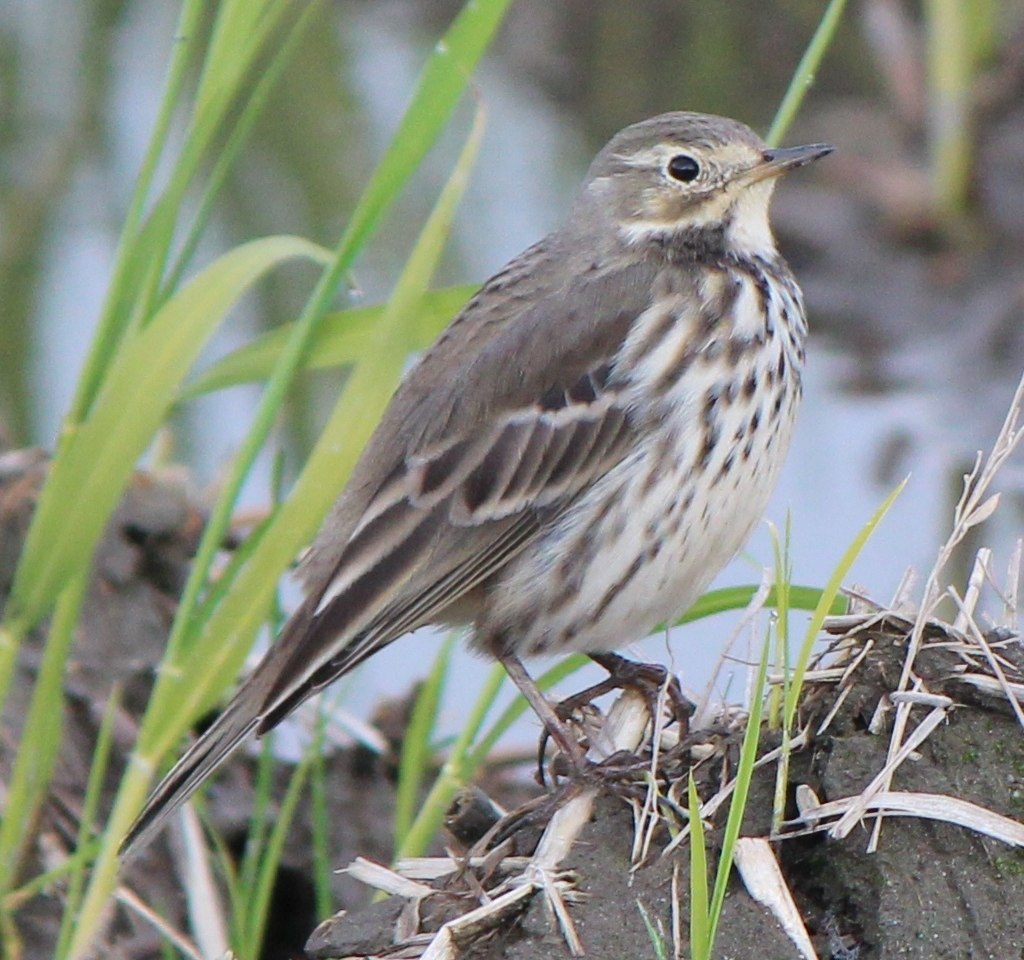
Coloration and Markings: American Pipits have gray or brown backs, typically with medium-length gray wings which are brown towards the outer edges and tips, and long, gray tails. The underbelly is a mix of white, gray, and some buff coloration, with the breast being more gray and buff colored. Facially, these birds have gray chins and buff color under the cheeks, with the remainder of the head being gray with a buff eyeline and a small, curved white eyebrow line. These birds have long, thin, and straight black bills.
Size: These birds measure in at 5.5 – 6.7 inches from head to tail and have wingspans of approximately 10.6 inches wide.
Habitat: Pipits favor open and especially bare areas, spending time in meadows, mudflats, or even tundra environs.
Diet: These birds prefer to eat insects, crustaceans, and fish. You might have a little luck with live or dried mealworms in your backyard feeder, but we cannot make any promises with these shy birds.
Horned Lark – Eremophila alpestris

Coloration and Markings: Male Horned Larks are a mix of brown and rust or simply sandy colored on their backs, with long, broad wings of the same color and medium length tails. The underbelly and breast of this bird are white with grays mixed in, and there is a flanking of brown coloration on the sides. Facially, these birds have mostly yellow faces, with a black line at the base of the throat as well as a black mask that goes through the eyes and begins curving downwards after it passes through them. The top and back of the bird’s head is brown and a black line encircles the crow, with black tufts often sticking up like horns. These birds have small, straight black bills with a hook at the tip of the tp bill and with some white often being present on the lower. Females will have the same coloration but lack the contrast of the males.
Size: These birds measure in at 6.3 – 7.9 inches and have wingspans of 11.8 to 13.4 inches wide.
Habitat: These birds like open areas, such as shrublands, tundra, and even stretches of desert. For them, the barer the ground, the better.
Diet: Primarily insectivores, you might have some luck with suet but it is unlikely. Try adding some live mealworms to your feeders and this might just do the trick.
Supporting cast (Other Backyard Birds of Michigan that might pay you a visit)
While we’ve already listed some year-round resident birds we like to include a ‘bonus section’, if you will, with some additional birds that you can look for at any time of year. We refer to these birds as our ‘supporting cast’ and while they don’t get that front-page publicity they are nonetheless quite beautiful and more than happy to visit a well-stocked backyard feeder. Keep an eye out for one of these supporting cast birds this year:
- Downy Woodpecker
- Black-capped Chickadee
- Mourning Dove
- House Sparrow
- Blue Jay
Downy Woodpecker – Picoides pubescens
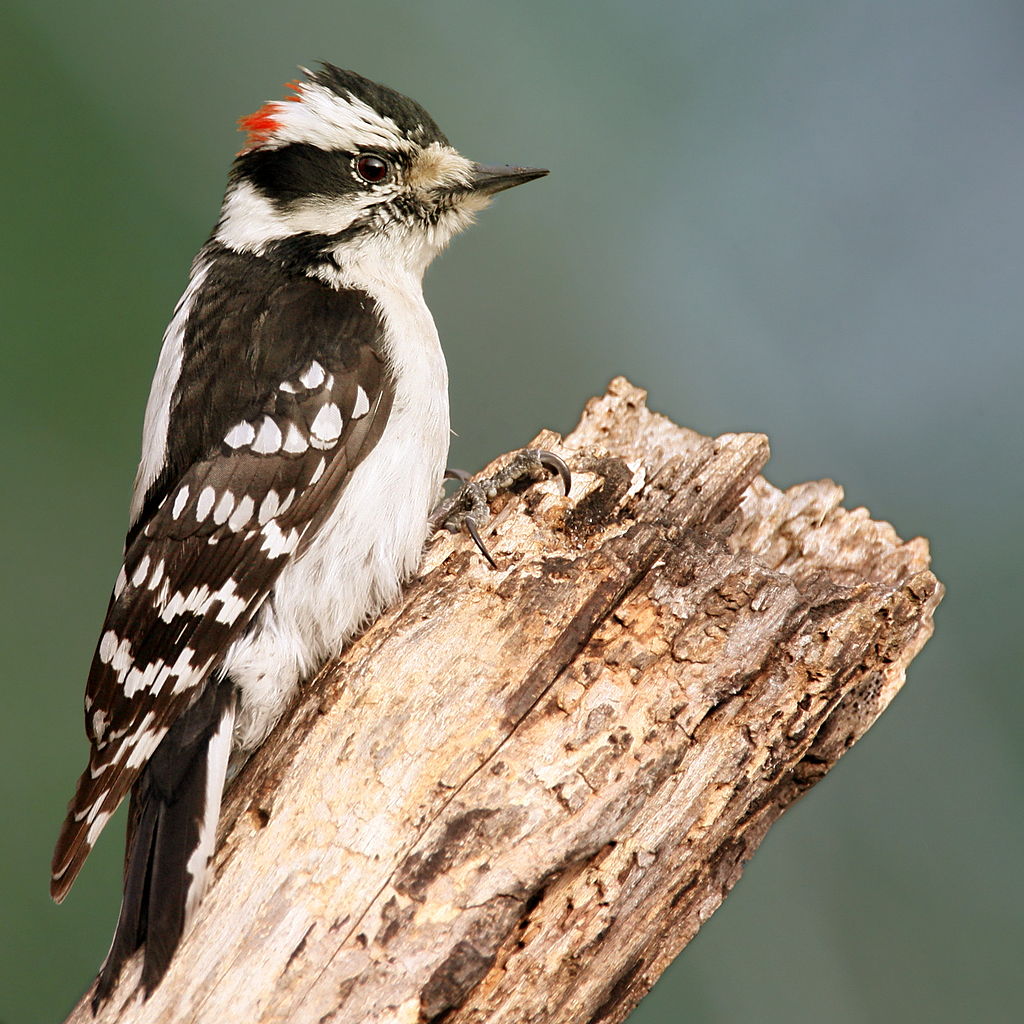
Coloration and Markings: Downy Woodpeckers are lovely little birds and the smallest North American species of Woodpecker. They have a broad, white stripe on their back and long, black wings with white blocks making stripe patterns starting just below the shoulders and down to the wingtips. They have short, notched tails which are black on top and white on the edges and undersides and their underbelly and breast is snowy white. Facially, these birds have white faces with a black mustache line, a black mask, and a black cap which terminates at the back of the head with a red spot in males, but stays black in females. These birds have straight, medium-length black bills.
Size: These birds measure in at 5.5 – 6.7 inches in length and have wingspans of 9.8 to 11.8 inches wide.
Habitat: Downies prefer deciduous regions, especially where there is heavy cover in the form of brushes, brambles, thickets, and thorns. They do range out quite often, however, visiting parks, orchards, gardens, and backyards with well-stocked feeders.
Diet: These birds like suet, peanut butter, Black Oil sunflower seeds, and they might even take a sip out of your hummingbird feeder!
Black-capped Chickadee – Poecile atricapillus
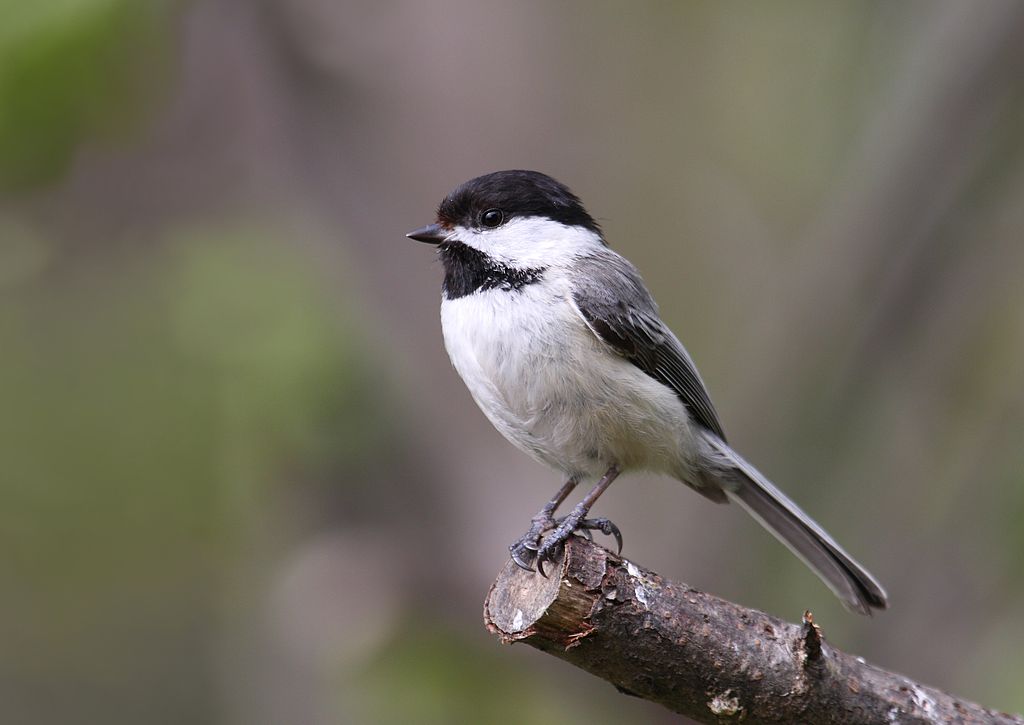
Coloration and Markings: Black-capped Chickadees are tiny birds with gray backs and small, gray wings with some white edging present, along with medium-length gray tails which are white underneath and at the edges. They have a white underbelly and breast with a dim flanking of tan coloration at the sides and facially, these birds have white faces with black chins and a large, black cap which settles down at mid-eye level. These birds have tiny, triangular black bills.
Size: These little guys and gals measure in at just 4.7 – 5.9 inches and have wingspans of 6.3 to 8.3 inches wide.
Habitat: Anywhere that you find trees with brush, bramble, thickets, or thorns nearby then you might spot a Chickadee and they also like cattail marshes as well. They are fond of overgrown fields and happy to visit a well-stocked backyard feeder.
Diet: Suet along with whatever sweet berries you happen to have on hand are all that you need to make backyard Chickadee visitors into happy birds indeed.
Mourning Dove – Zenaida macroura
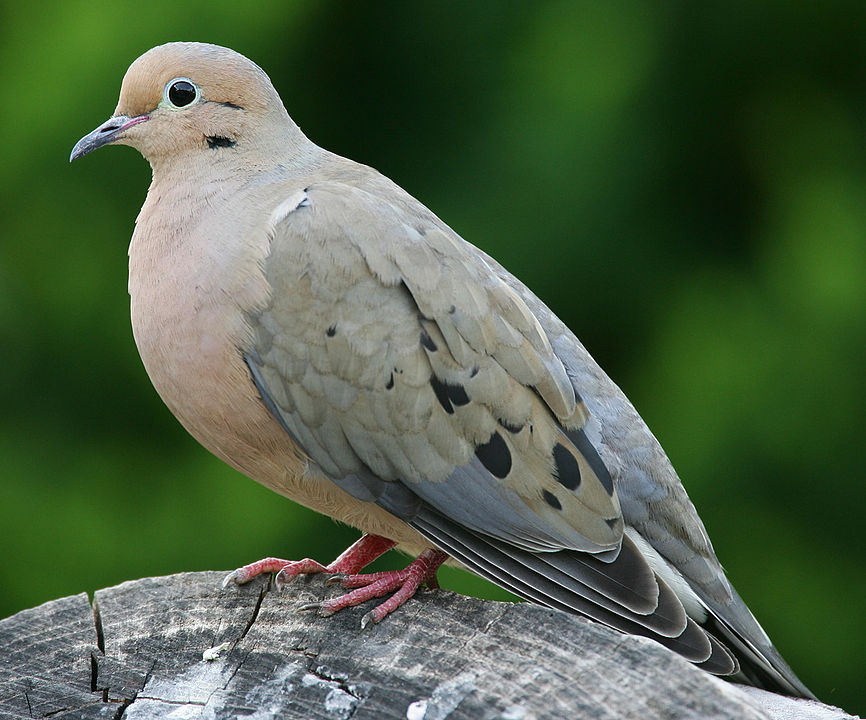
Coloration and Markings: Mourning Doves have gray backs with light brown or tan often present, as well as medium-length wings with a heavy concentration of tan towards the center along with some distinctive, large black spots. They have long, thin tails, and the underbelly and breast of this bird are white with a heavy mix of creamy tan coloration. These birds have tan faces, with cute, visible white eyerings and medium length, thin black bills.
Size: These Doves measure in at 9.1 – 13.4 inches from tip to tail and haqve wingspans of approximately 17.7 inches wide.
Habitat: Mourning Doves prefer to spend their time at the forest’s edge, rather than inside it, or even just in the city, where you can spot them on fences or walking down the sidewalk as they look for a snack.
Diet: Cracked corn, White Proso millet, and Black Oil sunflower seeds are sure to get this Dove’s attentions and might just make you a new feathered friend.
House Sparrow – Passer domesticus

Coloration and Markings: Male House Sparrows have rufous colored backs with black highlights as well as small wings and medium-length, perky tails of the same color. The undersides of the tail will be a mix of gray and rufous color, however, and the underbelly and breast of this bird are a ‘dirty’ gray and white, with a concentration of dotted black color at the top of the breast coming down from the face. Facially, these birds have a black chin, with white cheeks and white at the base of the neck with a lovely brown eyestripe which starts as black just in front of the eyes, turning brown as it passed them. It is thick and curves around to frame the underside of the cheek. At the bird’s crown we have a wide, silver stripe, and these birds have stout, medium-length bills with a slight curve. Females will be more of a drab brown color with grays and browns at the underbelly and breast and buff, black, and brown striping on their backs.
Size: These birds measure in at 5.9 – 6.7 inches in length and have wingspans of 7.9 to 9.8 inches wide.
Habitat: House Sparrows may sometimes be found in farms but that’s about as close to nature as they want to get. These birds like living around us and so you can find them in farms, towns, and cities, looking for snacks in places where people are plentiful.
Diet: Cracked corn, oats, and wheat are 3 favorites of the House Sparrow which you can use to lure them in and potentially keep them for a while as backyard guests.
Blue Jay – Cyanocitta cristata
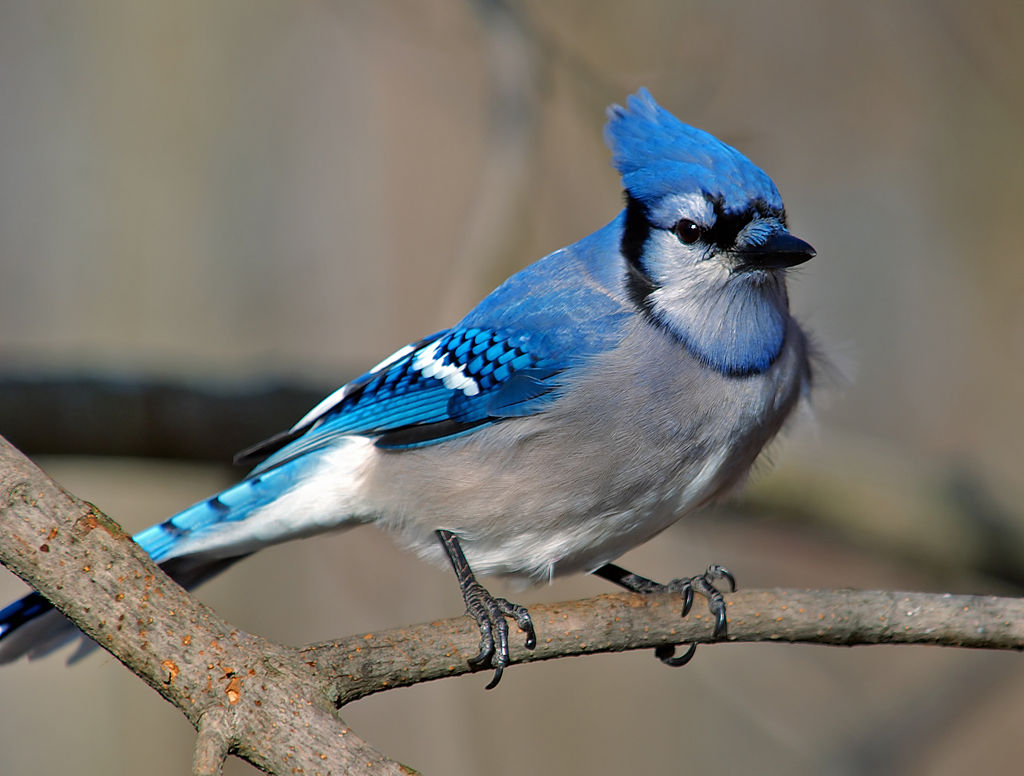
Coloration and Markings: Blue Jays have quite striking plumage and have inspired many to take up birdwatching. They have light blue backs with medium-length blue wings and long, broad, and rounded tails. The wings have 1 white wingbar each and display a ‘scaling’ patter of blue outlined in black above the wingbars and display some below, towards the center, as well. Here you will also see large white spots outlined in black while the tail will have more symmetrical patterns, with light blue squares on each side of the tail that are outlined in darker blue and accompanied with white outer feathers. The underbelly and breast of the Blue Jay are a snowy white which goes up into the face, interrupted briefly by a black line that starts at the back of the bird’s lovely blue crest and goes down to encircle the throat and back up the other side. Facially, these birds are mostly white, with the exceptions of the crest and the birds somewhat abstract black eyemask and its long, straight black bill.
Size: These birds measure in at 9.8 – 11.8 inches in length and have wingspans of 13.4 to 16.9 inches wide.
Habitat: Blue Jays love spending time at the forest’s edge and are especially fond of Oak stands, where they may obtain acorns to smash open as a delicious snack. They are bold, however, so you can see them quite often in parks or cities as well.
Diet: Suet, peanuts, cracked corn, and Black Oil sunflower seeds are all favorites of the Blue Jay. These easy-to-please birds are quite happy to eat just about anything that you leave out but for real fun put out a birdbath if you’ve got one. Blue Jays love to take baths and will make good use of it and that’s a spectacle that you don’t want to miss!
Michigan Bird Buffet
When you are stocking up your feeders in preparations for a few feathered visitors it always helps to have a little inside information. Today we’re going to share a few of our own recommendations for foods which you can add to your feeder and we’ve also got a few from the Michigan Department of Natural Resources. If you’d like to see their original article, simply check in our references at the close of this article and you can find the link there. In the meantime, here are some excellent additions for making that elusive ‘perfect feeder combination’ to attract the most diverse collection of local birds:
- Peanut-butter Suet mix
- Black Oil Sunflower seeds
- Nyjer thistle
- Grape jelly
- Wheat
- Rolled oats
Michigan Birding Hot Spots
When you wish to see the Michigan stars in their natural environs then you should take the Chirparazzi’s advice and try a few of their hotspots. We’ve collected a list of trails around Michigan that you can visit in your free time and who knows… if you bring a nice sack lunch and that camera of yours then you might just get a pic worth sharing and maybe even framing. If you don’t see any locations close to you then don’t worry, just use the link below our recommendations and you are sure to find something right around the corner! See if you can visit one of the following premium locales:
- Northern hotspot – North Central State Trail
- Eastern hotspot – Cass City Walking Trail
- Southern hotspot – Baw Beese Trail
- Western hotspot – Fred Meijer Berry Junction Trail
- Central hotspot – Pere Marquette State Trail
Detailed descriptions of each location as well as information regarding visiting and what birds you can see at these locations may be found at https://www.traillink.com/stateactivity/mi-birding-trails/
Some Final Words
This concludes our exploration into the extremely diverse birding experience that is Michigan, but your exploration is just beginning! We hope that you will use the tips which we have provided to your advantage and with a little bit of the recommended feeder-tweaking you might never even need to go any further than your backyard to see some of the best birds around. Until next time, we wish you our birding best!
